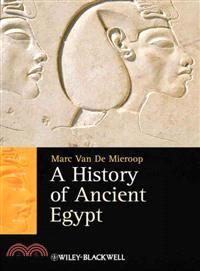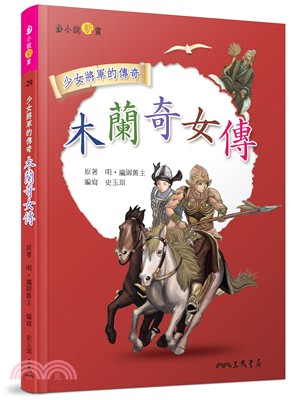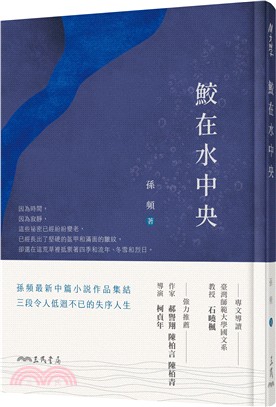History Of Ancient Egypt
商品資訊
系列名:Blackwell History of the Ancient World
ISBN13:9781405160704
出版社:John Wiley & Sons Inc
作者:Van De Mieroop
出版日:2010/08/13
裝訂/頁數:精裝/424頁
定價
:NT$ 5054 元優惠價
:90 折 4549 元
若需訂購本書,請電洽客服 02-25006600[分機130、131]。
商品簡介
作者簡介
目次
相關商品
商品簡介
Outlining the major political and cultural events, A History of Ancient Egypt is an authoritative and accessible introduction to this fascinating ancient culture.
An accessible chronological narrative that draws on a range of historical sources
Offers an up-to-date survey of ancient Egypt’s history from its origins to its domination by the Roman Empire
Considers social and economic life and the rich culture of ancient Egypt
Places Egypt’s history within its regional context, detailing interactions with Asia and Africa
Engages students with various perspectives on a range of critical issues with the Key Debate section included in each chapter
Makes the latest discoveries and scholarship accessible to a wide audience
An accessible chronological narrative that draws on a range of historical sources
Offers an up-to-date survey of ancient Egypt’s history from its origins to its domination by the Roman Empire
Considers social and economic life and the rich culture of ancient Egypt
Places Egypt’s history within its regional context, detailing interactions with Asia and Africa
Engages students with various perspectives on a range of critical issues with the Key Debate section included in each chapter
Makes the latest discoveries and scholarship accessible to a wide audience
作者簡介
Marc Van De Mieroop is Professor of History at Columbia University. He is the author and editor of numerous publications on the Ancient Near East and ancient Egypt, including A History of the Ancient Near East, ca. 3000 - 323 B.C., 2nd edition (Wiley-Blackwell, 2007), The Eastern Mediterranean in the Age of Ramesses II (Wiley-Blackwell, 2007) and King Hammurabi of Babylon (Wiley-Blackwell, 2005).
目次
List of Illustrations.
List of Color Plates.
List of Maps.
List of Boxed Texts.
List of Summaries of Dynastic History.
Preface.
1. Introductory Concerns.
1.1 What Is Ancient Egypt?.
1.2 Egypt’s Geography.
1.3 The Makeup of Egyptian Historical Sources.
1.4 The Egyptians and their Past.
1.5 The Chronology of Egyptian History.
1.6 Prehistoric Developments.
2. The Formation of the Egyptian State (ca. 3400–2686).
2.1 Sources.
2.2 Royal Cemeteries and Cities.
2.3 The First Kings.
2.4 Ideological Foundations of the New State.
2.5 The Invention of Writing.
2.6 Foreign Relations.
3. The Great Pyramid Builders (ca. 2686–2345).
3.1 Sources.
3.2 The Evolution of the Mortuary Complex.
3.3 Administrating the Old Kingdom State.
3.4 Ideological Debates?.
3.5 Foreign Relations.
3.6 Later Traditions about the Old Kingdom.
4. The End of the Old Kingdom and the First Intermediate Period (ca. 2345–2055).
4.1 Sources.
4.2 The Rise of the Regions and Political Fragmentation.
4.3 Foreign Relations.
4.4 Competition between Herakleopolis and Thebes.
4.5 Appraising the First Intermediate Period.
5. The Middle Kingdom (ca. 2055–1650).
5.1 Sources and Chronology.
5.2 Kings and Regional Elites.
5.3 Kings as Warriors.
5.4 Egypt in the Wider World.
5.5 The Cult of Osiris.
5.6 Middle Kingdom Literature and Its Impact on Egyptian Culture.
6. The Second Intermediate Period and the Hyksos (ca. 1700–1550).
6.1 Sources and Chronology.
6.2 Avaris: The Multiple Transformations of a Delta City.
6.3 The Hyksos.
6.4 Nubia and the Kingdom of Kush.
6.5 Thebes in the Middle.
6.6 The Hyksos in Later Perspective.
7. The Birth of Empire: The Early 18th Dynasty (ca. 1550–1390).
7.1 Egypt in a New World Order.
7.2 Sources and Chronology.
7.3 Egypt at War.
7.4 Egypt and the Outside World.
7.5 Domestic Issues.
8. The Amarna Revolution and the Late 18th Dynasty (ca. 1390–1295).
8.1 An International Age.
8.2 Amenhotep III: The Sun King.
8.3 From Amenhotep III to Amenhotep IV/Akhenaten.
8.4 Akhenaten.
8.5 Akhenaten’s Memory.
9. The Ramessid Empire (ca. 1295–1203).
9.1 Domestic Policy: Restoration and Renewal.
9.2 International Relations: Reforming the Empire.
9.3 Rameses’s Court.
9.4 A Community of Tomb Builders.
10. The End of Empire (ca. 1213–1070).
10.1 Problems at Court.
10.2 Breakdown of Order.
10.3 The Decline of Royal Power.
10.4 Pressures from Abroad.
10.5 End of the New Kingdom.
11. The Third Intermediate Period (ca. 1069–715).
11.1 Sources and Chronology.
11.2 Twin Cities: Thebes and Tanis (the 21st Dynasty, 1069–945).
11.3 Libyan Rule (22nd to 24th Dynasties, 945–715).
11.4 The End of the Third Intermediate Period.
12. Egypt in the Age of Empires (ca. 715–332).
12.1 Sources and Chronology.
12.2 The Eastern Mediterranean in the First Millennium.
12.3 Egypt, Kush, and Assyria (ca. 715–656).
12.4 Egypt, Greeks, and Babylonians (656–525).
12.5 Recollections of the Past under the Kings of Kush and Sais.
12.6 Egypt and Persia (525–332).
13. Greek and Roman Egypt (332 bc–ad 395).
13.1 Sources and Chronology.
13.2 Alexandria and Philae.
13.3 Kings, Queens, and Emperors.
13.4 Greeks, Romans, and Egyptians.
13.5 Economic Developments: Agriculture, Finance, and Trade.
13.6 The African Hinterland.
13.7 The Christianization of Egypt.
Epilogue.
Guide to Further Reading.
Glossary.
King List.
Bibliography.
Index.
List of Color Plates.
List of Maps.
List of Boxed Texts.
List of Summaries of Dynastic History.
Preface.
1. Introductory Concerns.
1.1 What Is Ancient Egypt?.
1.2 Egypt’s Geography.
1.3 The Makeup of Egyptian Historical Sources.
1.4 The Egyptians and their Past.
1.5 The Chronology of Egyptian History.
1.6 Prehistoric Developments.
2. The Formation of the Egyptian State (ca. 3400–2686).
2.1 Sources.
2.2 Royal Cemeteries and Cities.
2.3 The First Kings.
2.4 Ideological Foundations of the New State.
2.5 The Invention of Writing.
2.6 Foreign Relations.
3. The Great Pyramid Builders (ca. 2686–2345).
3.1 Sources.
3.2 The Evolution of the Mortuary Complex.
3.3 Administrating the Old Kingdom State.
3.4 Ideological Debates?.
3.5 Foreign Relations.
3.6 Later Traditions about the Old Kingdom.
4. The End of the Old Kingdom and the First Intermediate Period (ca. 2345–2055).
4.1 Sources.
4.2 The Rise of the Regions and Political Fragmentation.
4.3 Foreign Relations.
4.4 Competition between Herakleopolis and Thebes.
4.5 Appraising the First Intermediate Period.
5. The Middle Kingdom (ca. 2055–1650).
5.1 Sources and Chronology.
5.2 Kings and Regional Elites.
5.3 Kings as Warriors.
5.4 Egypt in the Wider World.
5.5 The Cult of Osiris.
5.6 Middle Kingdom Literature and Its Impact on Egyptian Culture.
6. The Second Intermediate Period and the Hyksos (ca. 1700–1550).
6.1 Sources and Chronology.
6.2 Avaris: The Multiple Transformations of a Delta City.
6.3 The Hyksos.
6.4 Nubia and the Kingdom of Kush.
6.5 Thebes in the Middle.
6.6 The Hyksos in Later Perspective.
7. The Birth of Empire: The Early 18th Dynasty (ca. 1550–1390).
7.1 Egypt in a New World Order.
7.2 Sources and Chronology.
7.3 Egypt at War.
7.4 Egypt and the Outside World.
7.5 Domestic Issues.
8. The Amarna Revolution and the Late 18th Dynasty (ca. 1390–1295).
8.1 An International Age.
8.2 Amenhotep III: The Sun King.
8.3 From Amenhotep III to Amenhotep IV/Akhenaten.
8.4 Akhenaten.
8.5 Akhenaten’s Memory.
9. The Ramessid Empire (ca. 1295–1203).
9.1 Domestic Policy: Restoration and Renewal.
9.2 International Relations: Reforming the Empire.
9.3 Rameses’s Court.
9.4 A Community of Tomb Builders.
10. The End of Empire (ca. 1213–1070).
10.1 Problems at Court.
10.2 Breakdown of Order.
10.3 The Decline of Royal Power.
10.4 Pressures from Abroad.
10.5 End of the New Kingdom.
11. The Third Intermediate Period (ca. 1069–715).
11.1 Sources and Chronology.
11.2 Twin Cities: Thebes and Tanis (the 21st Dynasty, 1069–945).
11.3 Libyan Rule (22nd to 24th Dynasties, 945–715).
11.4 The End of the Third Intermediate Period.
12. Egypt in the Age of Empires (ca. 715–332).
12.1 Sources and Chronology.
12.2 The Eastern Mediterranean in the First Millennium.
12.3 Egypt, Kush, and Assyria (ca. 715–656).
12.4 Egypt, Greeks, and Babylonians (656–525).
12.5 Recollections of the Past under the Kings of Kush and Sais.
12.6 Egypt and Persia (525–332).
13. Greek and Roman Egypt (332 bc–ad 395).
13.1 Sources and Chronology.
13.2 Alexandria and Philae.
13.3 Kings, Queens, and Emperors.
13.4 Greeks, Romans, and Egyptians.
13.5 Economic Developments: Agriculture, Finance, and Trade.
13.6 The African Hinterland.
13.7 The Christianization of Egypt.
Epilogue.
Guide to Further Reading.
Glossary.
King List.
Bibliography.
Index.
主題書展
更多
主題書展
更多書展今日66折
您曾經瀏覽過的商品
購物須知
外文書商品之書封,為出版社提供之樣本。實際出貨商品,以出版社所提供之現有版本為主。部份書籍,因出版社供應狀況特殊,匯率將依實際狀況做調整。
無庫存之商品,在您完成訂單程序之後,將以空運的方式為你下單調貨。為了縮短等待的時間,建議您將外文書與其他商品分開下單,以獲得最快的取貨速度,平均調貨時間為1~2個月。
為了保護您的權益,「三民網路書店」提供會員七日商品鑑賞期(收到商品為起始日)。
若要辦理退貨,請在商品鑑賞期內寄回,且商品必須是全新狀態與完整包裝(商品、附件、發票、隨貨贈品等)否則恕不接受退貨。
























